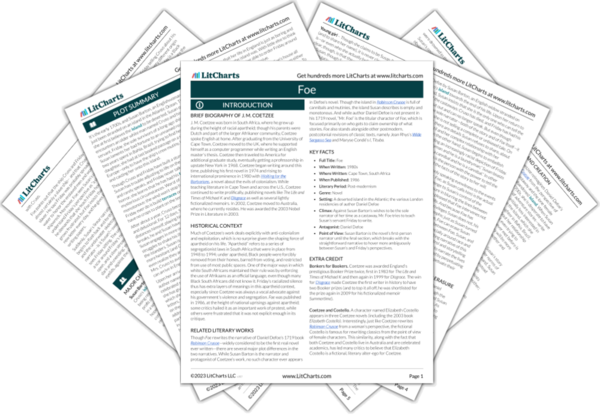Welcome to the LitCharts study guide on J. M. Coetzee's Foe. Created by the original team behind SparkNotes, LitCharts are the world's best literature guides.
Foe: Introduction
Foe: Plot Summary
Foe: Detailed Summary & Analysis
Foe: Themes
Foe: Quotes
Foe: Characters
Foe: Symbols
Foe: Theme Wheel
Brief Biography of J. M. Coetzee

Historical Context of Foe
Other Books Related to Foe
- Full Title: Foe
- When Written: 1980s
- Where Written: Cape Town, South Africa
- When Published: 1986
- Literary Period: Post-modernism
- Genre: Novel
- Setting: A deserted island in the Atlantic; the various London residencies of author Daniel Defoe
- Climax: Against Susan Barton’s wishes to be the sole narrator of her time as a castaway, Mr. Foe tries to teach Susan’s servant Friday to write.
- Antagonist: Daniel Defoe
- Point of View: Susan Barton is the novel’s first-person narrator until the final section, which breaks with the straightforward narrative to hover more ambiguously between Susan’s and Friday’s perspectives.
Extra Credit for Foe
Bonkers for Bookers. Coetzee was awarded England’s prestigious Booker Prize twice, first in 1983 for The Life and Times of Michael K and then again in 1999 for Disgrace. The win for Disgrace made Coetzee the first writer in history to have two Booker prizes (and to top it all off, he was shortlisted for the prize again in 2009 for his fictionalized memoir Summertime).
Coetzee and Costello. A character named Elizabeth Costello appears in three Coetzee novels (including the 2003 book Elizabeth Costello). Interestingly, just like Coetzee rewrites Robinson Crusoe from a woman’s perspective, the fictional Costello is famous for rewriting classics from the point of view of female characters. This similarity, along with the fact that both Coetzee and Costello live in Australia and are celebrated academics, has led many critics to believe that Elizabeth Costello is a fictional, literary alter-ego for Coetzee.







